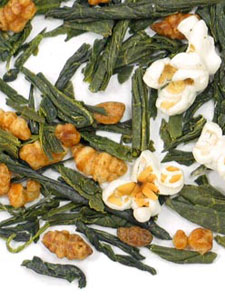Genmai Cha: The History of a Unique Taste

If you are looking to serve your customers tea with an interesting history, Genmai Cha is tough to beat.
Tea has historically been a luxury item. This was even true in places responsible for its production, like China and Japan. While the Samurai class had no problem getting its hands on ample supply, the lowly peasants could scarcely afford it. The few grams of tea they could afford would usually not last very long. Something needed to be done to prolong its longevity.
Unlike tea, the Japanese rice was both plentiful and inexpensive. Diluting tea with a handful of roasted rice was one way that a limited amount of tea could be made to last longer. Out of this opportune desperation, a tradition was born of combining tea leaves with rice, producing a mixture called Genmai Cha.
Genmai Cha is typically made with green leaves gathered later in the fall. Called "bancha," these tend to be larger and coarser than the delicate spring leaves that make up Japan's "sencha" crop. Bancha leaves typically lack the flavor for which early-season teas are revered, and therefore are priced accordingly. So yet another aspect of Genmai Cha's remarkable recipe, the use of the bancha leaves, was precipitated by economics.
For many years, Genmai Cha remained a poor man's drink. The upper classes remained aloof of it, seeing no need to adulterate their beverage with anything as coarse and commonplace as rice. But then, as it often happens, the hipsters discovered its appeal. As we see in current trends like trucker hats and miners' jeans before them, Genmai Cha was instantly transformed from a indication of poverty to an object of desire, a sure sign that its consumer's membership among the cool and trendy.
With price no longer an impediment, the tea used in the mix began to improve. No longer limited to inexpensive bancha, Genmai Cha became a tea one could select on taste. Combining the smooth notes of young green tea with nutty notes of rice, Genmai Cha's flavor was as distinct and inimitable as any tea aficionado had ever tasted. Often added for effect, popped corn was certainly a pleasure for the eyes as well as the taste buds.
All of these aspects combined make Genmai Cha a great "gateway" tea. It is an easy tea to savor for those new to green teas. The "grassy," and "spinach-y" notes that often turn green tea neophytes off are sweetened and refined with nutty overtones of rice. It has a unique taste that most are sure to find unusually pleasing. When recommending green tea to those not yet exposed to it, Genmai Cha is a natural choice.
Unfortunately, for some providers "old habits die hard." Most of Genmai Cha offered in this country contains the money-saving bancha leaves (these large and flaky leaves are easy to spot). Given that your customers are better heeled than a Meiji peasant and are surely paying more per cup, they may enjoy a better drink. Look instead for a tea which combines popped corn and rice with delicate, spring-gathered leaves (which are narrow, long, and vibrant; reminiscent of fresh pine needles). With a price difference of only about nickel per cup, the enormous improvement in taste is surely worth it. This is something your customers are sure to notice and will gratefully reward you for.

